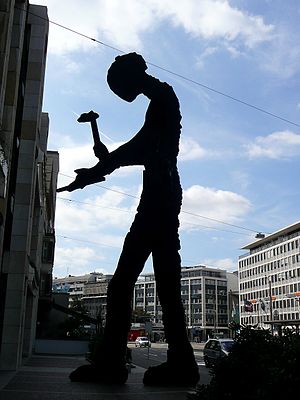
As manufacturing goes digital, it will change out of all recognition, says Paul Markillie.
And some of the business of making things will return to rich countries
OUTSIDE THE SPRAWLING Frankfurt Messe, home of innumerable German trade fairs, stands the “Hammering Man”, a 21-metre kinetic statue that steadily raises and lowers its arm to bash a piece of metal with a hammer. Jonathan Borofsky, the artist who built it, says it is a celebration of the worker using his mind and hands to create the world we live in. That is a familiar story. But now the tools are changing in a number of remarkable ways that will transform the future of manufacturing.
One of those big trade fairs held in Frankfurt is EuroMold, which shows machines for making prototypes of products, the tools needed to put those things into production and all manner of other manufacturing kit. Old-school engineers worked with lathes, drills, stamping presses and moulding machines. These still exist, but EuroMold exhibits no oily machinery tended by men in overalls. Hall after hall is full of squeaky-clean American, Asian and European machine tools, all highly automated. Most of their operators, men and women, sit in front of computer screens. Nowhere will you find a hammer.
And at the most recent EuroMold fair, last November, another group of machines was on display: three-dimensional (3D) printers. Instead of bashing, bending and cutting material the way it always has been, 3D printers build things by depositing material, layer by layer. That is why the process is more properly described as additive manufacturing. An American firm, 3D Systems, used one of its 3D printers to print a hammer for your correspondent, complete with a natty wood-effect handle and a metallised head.
This is what manufacturing will be like in the future. Ask a factory today to make you a single hammer to your own design and you will be presented with a bill for thousands of dollars. The makers would have to produce a mould, cast the head, machine it to a suitable finish, turn a wooden handle and then assemble the parts. To do that for one hammer would be prohibitively expensive. If you are producing thousands of hammers, each one of them will be much cheaper, thanks to economies of scale. For a 3D printer, though, economies of scale matter much less. Its software can be endlessly tweaked and it can make just about anything. The cost of setting up the machine is the same whether it makes one thing or as many things as can fit inside the machine; like a two-dimensional office printer that pushes out one letter or many different ones until the ink cartridge and paper need replacing, it will keep going, at about the same cost for each item.
Additive manufacturing is not yet good enough to make a car or an iPhone, but it is already being used to make specialist parts for cars and customised covers for iPhones. Although it is still a relatively young technology, most people probably already own something that was made with the help of a 3D printer. It might be a pair of shoes, printed in solid form as a design prototype before being produced in bulk. It could be a hearing aid, individually tailored to the shape of the user’s ear. Or it could be a piece of jewellery, cast from a mould made by a 3D printer or produced directly using a growing number of printable materials.
But additive manufacturing is only one of a number of breakthroughs leading to the factory of the future, and conventional production equipment is becoming smarter and more flexible, too. Volkswagen has a new production strategy called Modularer Querbaukasten, or MQB. By standardising the parameters of certain components, such as the mounting points of engines, the German carmaker hopes to be able to produce all its models on the same production line. The process is being introduced this year, but will gather pace as new models are launched over the next decade. Eventually it should allow its factories in America, Europe and China to produce locally whatever vehicle each market requires.
They don’t make them like that any more
Factories are becoming vastly more efficient, thanks to automated milling machines that can swap their own tools, cut in multiple directions and “feel” if something is going wrong, together with robots equipped with vision and other sensing systems.
via The Economistᔥ
Bookmark this page for “future manufacturing” and check back regularly as these articles update on a very frequent basis. The view is set to “news”. Try clicking on “video” and “2” for more articles.







